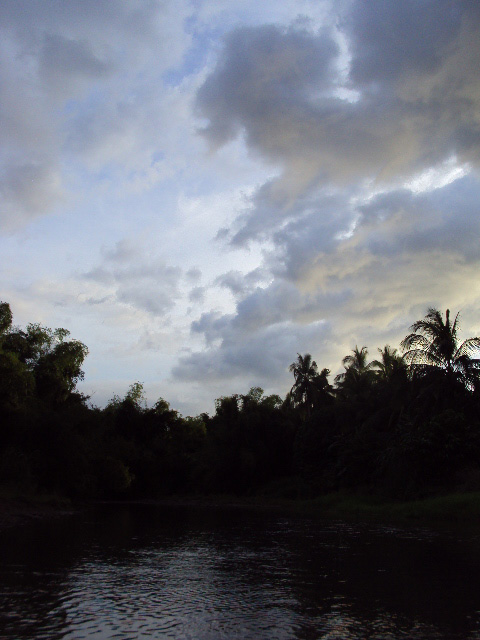本文作者:寶羅
RIVER CRUISING ON A SUNDAY AFTERNOON
a Reflection by:paul
Gerard planned this trip to the boondocks of Siaton. It was to bring our Australian visitors Ressy and Fe outing and to satisfy our clamor to be with the pristine outdoors. We left home around 2:30 PM after a wonderful family celebration of Junior’s birthday at the newly opened Mandarin restaurant.
Then with the two pickups one following the other, mounting a canoe on each, perched at the roof, we drove deeper into the interior. After passing several fields of corn and sugarcane, we finally made a stop in the middle of a very narrow dirt passage.
Or Gerard may have chosen this part because it was at the end of the road. With the help of the three workers, we prepared the motors and all the gears. Gerard, Ressy, Fe and Arry boarded their canoe while Inny, Theresa and I together with Gerard’s trusted Manfriday boarded ours. It was on a part where bamboo grooves lined the banks covering most of the sun from us as we faced a lonely Acacia tree on the other bank. Thus begun our two-hour downstream cruise on the Kanaway River.
What was hard to miss was the uniformly spaced bamboo grooves on both banks, and the carabaos taking their afternoon cool dip. We would encounter a carabao or two, now and then, when the depth of the river was enough to engulf these hard working animals up to their necks. But it was almost certain that on the sections where no carabao was bathing itself...
...the water would be so shallow, we would have to stop the electric propeller. Then we would hear the screech of the canoe’s belly brazing against the stones. It was time to come down and push the boats. At one point we had to make adjustments on the propeller-motor assembly. Then the locking pin dropped. O-pao (the guide assigned to our canoe) and I frantically searched for the missing pin in the mud and stones of the river bed. We finally gave up.
But O-pao decided to get a piece of twig to replace the stainless pin. And then wonderfully the motor started to twirl the propeller again. I suddenly thought that if we could just replace all the stainless steels in the world with twigs and woods, would that not be wonderful?
But my thoughts were suddenly interrupted when a foot bridge suddenly appeared from nowhere. It was made of steel cable and floored with steel plate.
At first, I thought that the remaining trip would be dull because we missed the sunset.
 |
It darkened faster than we had anticipated. We stopped and came out knee deep to mount the lamps of the bow and then continued just as the egrets were coming home and the stars started to appear.
Theresa and I found ourselves singing Panis Angelicus
as we watched the stars begin to dominate the black sky.
(Our thanks to the owner of this picture. We took this from someone's website.
Our own camera failed to capture the fireflies that night,
but it was more spectacular than this.) We rowed under this canopy of stars for sometime in what seemed eternity. But suddenly Gerard calmly shouted to look on the left. I thought for a moment that the angels
have brought small stars very close to us and then very quickly realized that it was a tree
filled with one of God’s most wonderful creations showing off their white lights.
(this picture was taken from someone's website. Our own camera failed to capture the fireflies that night,
but it was more spectacular than this.) I have seen fireflies before but not as spectacular as these.Theresa wanted to let the boat stop as she jeered in awesome wonder expressing her disbelief that she could see them so close.
The display had finally come to greet her so unexpectedly. She had been asking the
past few weeks when we could go to Valenciato see the famous tree with the millions of fireflies in it. And now she was right in front of them!
And it suddenly dawned on me that it is Christmas again. Is today not the first day of Advent? Is today not the beginning of a new liturgical year bringing with it new hopes and expanding the horizon of meaning to our existence? Is it not so classic of God to choose such a simple and unassuming messenger to announce the coming of a Messiah? In his generosity and wisdom God designed one of nature’s most fascinating creatures perhaps to remind us sophisticated humans that beauty is discovered in simplicity. And simplicity can be learned from a creature so humble that it allows God’s light to pass through them in order to brighten this world.




















那条河看起来好宁静!
回覆刪除我这里也有一条可以看萤火虫的河,但由于成了旅游景点,连空气也被污染了,诚为可惜.
德希,我来看萤火虫了!谢谢宝罗与德希的珍贵分享!
回覆刪除我曾在纽西兰的萤火虫洞看过颇为壮观的飞舞萤火虫,真的是一种奇异而难忘的体验。
夫人,有空把马来西亚的萤火虫拍给我们看看如何?
回覆刪除旅游提升了村民的收入,但的确破坏了环境。我们这里发展缓慢,村民们真是生活在仙境中一般。希望很久都不要改变。。。。
德希
绿禾姐,您说的纽西兰的萤火虫洞我也有耳闻,你有这个的游记吗?我们也借你的旅行‘去那里’欣赏一下?呵呵
回覆刪除德希
那是好多年前的事了。那时候拍的照片都是用胶卷的,不能上载到电脑。还有洞里也不准拍照和说话。
回覆刪除下次和宝罗去游玩啦!
这样多萤火虫,相信一定很壮观!保罗的分享蛮有意思哦!诗艳特别喜欢这一句:In his generosity and wisdom God designed one of nature’s most fascinating creatures perhaps to remind us sophisticated humans that beauty is discovered in simplicity. And simplicity can be learned from a creature so humble that it allows God’s light to pass through them in order to brighten this world.
回覆刪除Hi Ms. Shi Yan, It is always nice to know someone appreciates our own reflection. Tessie asked me to write something while the experience was still fresh. I am happy the sharing also touched someone.
回覆刪除-paul
来看萤火虫了!
回覆刪除好美好美!
还没亲眼目睹酱多萤火虫,
好希望能跟它们做亲密的接触。
(梦中吧?)
CINGDY姐姐,你们马来西亚河边也有萤火虫的。(悄悄告诉你,我用的萤火虫的真实的图片就来自马来西亚)不过我们这里的也很美,来菲旅游吧。
回覆刪除